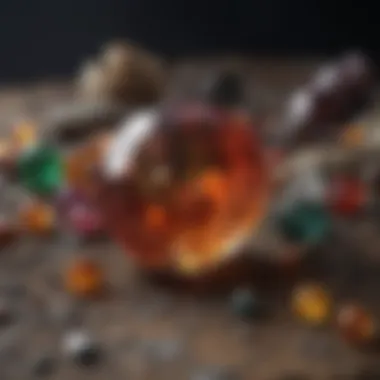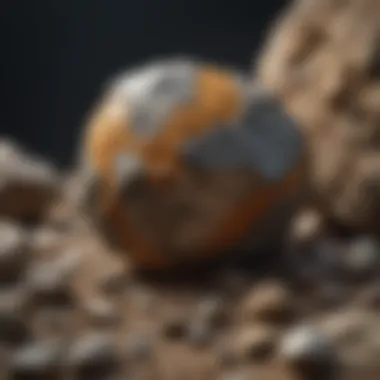Unveiling the Intricacies of Nat Geo Rock Tumbler Grit: A Definitive Guide for Rock and Fossil Enthusiasts


Rock and Fossil Identification
In the fascinating world of rock and fossil collecting, understanding the different types of rocks and fossils is paramount. Various rocks, such as igneous, sedimentary, and metamorphic, each boast unique characteristics that offer clues to their formation and history. Fossils, on the other hand, provide glimpses into prehistoric life, ranging from plant imprints to dinosaur bones. As collectors, having the right tools for identification is essential; magnifying glasses, field guides, and even hammer and chisel sets can all aid in this exciting endeavor.
Collecting Tips and Techniques
To excel in the art of rock and fossil collecting, one must embrace best practices and techniques. Successful collectors understand the importance of research, knowing where to locate prime collecting sites rich in geological treasures. Whether it's exploring desert valleys for fossilized remains or scouring riverbeds for polished gemstones, having a keen eye and proper tools is key. Moreover, learning how to safely extract specimens without causing damage is crucial for preserving the integrity of the finds.
Preservation and Display
Once the collection grows, the next step is preservation and display. To maintain the beauty and longevity of rocks and fossils, collectors utilize various techniques such as cleaning, sealing, and protecting them from environmental factors. Proper storage methods, including using acid-free paper, labeled boxes, and display cases, ensure that each specimen remains pristine for years to come. For creative individuals, the display of rocks and fossils provides an opportunity for artistic expression; from elegant shadow boxes to intricate shelving arrangements, the possibilities are endless.
Geological Insights
Beyond the physical aspects of rocks and fossils lie profound geological insights. Exploring the geological formations and processes that shaped these specimens offers a deeper appreciation for the Earth's history. Understanding the historical significance of certain rocks and fossils sheds light on past environments and the evolution of life. Notable discoveries in the field, whether it be a new species of dinosaur or a rare mineral deposit, continually push the boundaries of scientific knowledge and intrigue collectors with the wonders of the natural world.
Introduction to Rock Tumbling
Rock tumbling is a fascinating process that allows enthusiasts to transform rough, unpolished stones into beautifully polished gems and fossils. In this article, we delve deep into the world of rock tumbling, focusing specifically on the role of grit in achieving stunning results with Nat Geo products. Understanding the fundamentals of rock tumbling is essential for rock and fossil collectors looking to enhance their collection with expertly polished pieces.
What is Rock Tumbling?
Rock tumbling is a meticulous process that involves smoothing and polishing rough stones to reveal their inner beauty. By placing various types of stones in a tumbling machine with grit, water, and a few weeks of tumbling, the stones undergo a transformation into polished gemstones. This technique simulates the natural process of rivers and oceans smoothing out stones over time, but in a much shorter timespan.
Significance of Grit in Rock Tumbling


Understanding the Role of Grit Sizes
Grit plays a critical role in the rock tumbling process, as it serves to abrade the surfaces of stones, gradually smoothing out imperfections and revealing their true colors and patterns. The size of grit particles used determines the coarseness of the polishing action, with larger grit sizes being more abrasive and suitable for initial rough grinding stages. Understanding the different grit sizes and their effects on the stones is crucial for achieving desired results in rock tumbling with Nat Geo products.
Impact of Grit on the Tumbling Process
The choice of grit significantly impacts the efficiency and outcome of the tumbling process. Coarse grit is ideal for removing rough edges and shaping stones, while medium grit further refines the surfaces. Fine grit works to smooth out any remaining imperfections, preparing the stones for the final polishing stages. Polishing grit provides the finishing touch, creating a lustrous sheen on the stones. Each stage of grit selection influences the tumbling process, highlighting the importance of choosing the right sequence of grit sizes for optimal results.
Nat Geo Rock Tumbler Grit Selection
Nat Geo Rock Tumbler Grit Selection is a pivotal aspect within the context of this comprehensive guide on rock and fossil collection. When delving into the world of rock tumbling, the selection of grit plays a fundamental role in achieving desired outcomes. Nat Geo's range of grit options provides enthusiasts with a diverse array of choices tailored to different stages of the tumbling process. Understanding and mastering the selection of Nat Geo rock tumbler grit is crucial for enthusiasts looking to elevate their polishing skills and unveil the natural beauty of gemstones.
Variety of Grit Options by Nat Geo
Coarse Grit
Coarse Grit stands out as a foundational element in the rock tumbling process. Designed to facilitate the initial rough shaping of rocks, Coarse Grit boasts a key characteristic of strong abrasiveness, allowing it to swiftly remove rough edges and imperfections from stones. In this guide, Coarse Grit emerges as a popular choice for effectively preparing rocks for subsequent tumbling stages. While its aggressiveness accelerates the shaping process, users must handle Coarse Grit with care due to its abrasive nature.
Medium Grit
Medium Grit represents a crucial intermediary stage in the tumbling progression. With a moderate level of abrasiveness, Medium Grit plays a pivotal role in refining the surfaces of rocks after the initial Coarse Grit phase. Its key characteristic lies in its balanced abrasive properties, making it a versatile and widely beneficial option for achieving smooth and polished rock surfaces. Within this guide, Medium Grit emerges as an essential component in the grit sequence, contributing to the overall transformation of rocks into gem-like beauties.
Fine Grit
Fine Grit steps in as a refined polishing agent in the Nat Geo rock tumbler grit lineup. Boasting exceptionally fine particles, Fine Grit is instrumental in smoothing out rock surfaces and enhancing their luster. Its key characteristic of precision polishing distinguishes Fine Grit as a highly sought-after option for collectors aiming to achieve a superior level of shine and refinement in their gemstones. Throughout this guide, Fine Grit is spotlighted for its ability to elevate the aesthetic appeal of rocks to a polished sheen.


Polishing Grit
Polishing Grit serves as the final touch in the tumbling process, specializing in imparting a mirror-like finish to rocks. Its key characteristic lies in its ultra-fine abrasiveness, perfect for buffing and shining rocks to a radiant glow. Chosen for its ability to bring out the full beauty of gemstones, Polishing Grit is a popular choice among collectors seeking to showcase the intrinsic patterns and colors of rocks. This guide highlights Polishing Grit as the ultimate stage in achieving professional-quality results in rock tumbling, yielding stunning final products that captivate viewers with their brilliance.
Determining the Right Grit Sequence
Factors Influencing Grit Selection
Factors Influencing Grit Selection play a pivotal role in guiding collectors towards choosing the optimal grit types for their tumbling projects. Whether considering rock hardness, desired end results, or tumbling duration, these factors provide essential insights into selecting the most suitable grit sequence. This guide emphasizes the significance of considering these factors to tailor the grit progression effectively, ensuring the successful transformation of raw rocks into polished gemstones.
Optimal Grit Progression
Optimal Grit Progression is the key to unlocking the full potential of rock tumbling with Nat Geo grit. By strategically sequencing Coarse, Medium, Fine, and Polishing Grit, collectors can methodically enhance the appearance and texture of their rocks. The guide underscores the importance of following an optimal grit progression to maximize polishing efficiency and achieve professional-grade results. Understanding and implementing the right grit sequence are integral to creating stunning gemstones that dazzle with their beauty and craftsmanship.
Application and Techniques
Rock tumbling is an intricate process that requires precision and expertise. Within the realm of rock tumbling, the application of grit and various techniques play a crucial role in achieving desired results. In this article, we delve into the significance of mastering the application of grit and employing effective techniques for rock and fossil collectors seeking impeccable gemstones.
Best Practices for Using Nat Geo Grit
In the domain of rock tumbling, the quality of the finished product heavily relies on the initial steps taken. One essential aspect is Preparing Rocks for Tumbling. This process involves selecting the appropriate rocks, inspecting them for flaws, and ensuring they are of suitable size and shape for the tumbling process. Properly preparing rocks lays the foundation for a successful tumbling experience, enhancing the final outcome significantly. Additionally, it safeguards the tumbler from potential damages that may occur due to unsuitable rock selection.
Another critical facet is Applying Grit Effectively. This step requires precision and care to ensure uniform and efficient coating of the rocks. It involves understanding the right amount of grit needed, the optimal tumbling duration, and the frequency of grit replacement. Applying grit effectively not only enhances the tumbling process but also maximizes the polish and shine of the gemstones. However, improper application may result in uneven coating, longer tumbling times, and subpar results.
Advanced Tips for Enhanced Results


Taking rock tumbling to the next level involves experimenting with various Experimental Grit Combinations. These combinations allow collectors to achieve unique textures and finishes on their gemstones. By mixing different grit types and sizes strategically, collectors can uncover innovative polishing methods that elevate the beauty of their rocks. However, it is crucial to record and analyze the outcomes of these experiments to tailor future combinations for optimal results.
Furthermore, mastering Polishing Techniques refines the tumbling process, resulting in exceptional gemstones. Understanding the intricacies of polishing, such as pressure application, polishing duration, and post-polishing treatments, is essential for attaining a lustrous finish. Utilizing advanced polishing techniques can bring out the natural beauty of rocks and fossils, creating stunning pieces that captivate collectors and enthusiasts alike.
Maintenance and Safety
In the world of rock tumbling, maintenance and safety play a crucial role in ensuring not only the longevity of your equipment but also your well-being. Proper maintenance is essential for the efficient functioning of your rock tumbler and the quality of the tumbling process. Regular cleaning and upkeep of your equipment can prevent build-up and ensure consistent results. Additionally, safety measures are paramount to protect yourself from any potential hazards associated with handling grit and operating the tumbler.
Cleaning and Storing Grit Supplies
When it comes to cleaning and storing grit supplies, precision and care are key. Properly cleaning your grit supplies after each tumbling cycle is essential to prevent contamination and ensure optimal performance in subsequent tumbling sessions. Storing grit in airtight containers away from moisture and direct sunlight can help prolong its effectiveness and maintain its quality over time.
Ensuring Safe Handling Practices
Rock tumbling entails working with abrasive materials that require careful handling to avoid injury or exposure to harmful substances. Implementing safe handling practices is critical for minimizing risks and maximizing your enjoyment of the hobby.
Protective Gear Recommendations
Protective gear recommendations are designed to provide a layer of defense against potential hazards during the rock tumbling process. This may include wearing gloves, safety goggles, and a dust mask to protect your hands, eyes, and respiratory system from fine particles and chemicals. The key characteristic of protective gear recommendations lies in their ability to safeguard you against physical harm and respiratory irritation, ensuring a safe and comfortable tumbling experience. By wearing the recommended protective gear, you can mitigate risks and focus on the art of rock tumbling without compromising your safety.
Proper Ventilation
Proper ventilation is essential to maintain a healthy work environment while rock tumbling. Adequate ventilation helps disperse dust particles and fumes generated during the tumbling process, reducing the risk of respiratory issues and ensuring air quality. The unique feature of proper ventilation lies in its ability to create a safe and breathable space, promoting optimal conditions for rock tumbling activities. By prioritizing proper ventilation, you can enhance safety measures and create a more comfortable workspace for your tumbling endeavors.
Conclusion
In the realm of rock and fossil collecting, the conclusion plays a pivotal role in synthesizing the vast expanse of knowledge elucidated in this comprehensive guide exploring Nat Geo rock tumbler grit. This article has served as a beacon of wisdom for enthusiasts, shedding light on the intricate world of rock tumbling. As we wrap up this enlightening journey, it is essential to reflect on the key takeaways and insights gained throughout the exploration of Nat Geo's offerings.
The conclusion serves as a cornerstone for cementing the importance of grit selection in the rock tumbling process. By revisiting the significance of various grit sizes and their impact on the tumbling progression, individuals can grasp the nuanced art of achieving polished gemstones. This section encapsulates the essence of the guide, emphasizing the critical role that grit selection plays in elevating the quality of the final polished rocks.
Furthermore, the conclusion offers a moment of reflection for rock and fossil collectors, instilling a sense of accomplishment and empowerment. It underlines the value of meticulous grit progression in enhancing the overall polishing results, urging enthusiasts to embrace a methodical approach to achieve dazzling outcomes. Through a concise yet comprehensive wrap-up, this guide ensures that readers walk away with a profound understanding of Nat Geo rock tumbler grit and its transformative impact on their collecting endeavors.
In essence, the conclusion serves as the final stroke on a masterpiece, drawing together threads of knowledge and practical insights into a coherent tapestry of expertise. By encapsulating the core principles and benefits of rock tumbling grit selection, this guide equips readers with the tools and knowledge needed to embark on their rock collecting journey with confidence and finesse.







